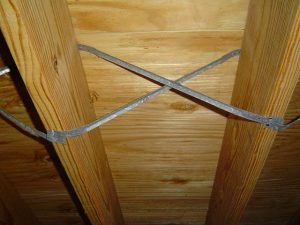How to Prevent or Fix your Home’s Squeaky Floors
By Mark J. Donovan
|
|
Squeaky floors are common in most homes, however it doesn’t have to be that way. Unfortunately in the process of saving a few dollars many home builders frequently neglect to use a construction adhesive, such as liquid nails, when securing the subfloor to the floor joists
Squeaky floors is the result of sections of subfloor edges either rubbing against one another, or the subfloor sections themselves moving up and down around the nails that secure them to the floor joists. To prevent subfloor sections from rubbing against each other or nails, a construction adhesive should be applied to the top of the floor joists just prior to nailing the subfloor to the floor joists. |
Once dried, the construction adhesive helps hold the subfloor to the floor joists, minimizing any subfloor movement. So, if you are having a new home built, be sure to insist on the use of construction adhesive when applying the subfloor.
You will need to take care not to use too long of a screw that could penetrate the finished floor surface above. Also, just prior to installing the screw apply a bead of construction adhesive into the space.
You will want the person above to step off of the floor area when applying the adhesive to enable sufficient penetration of the adhesive in-between the floor joist and the subfloor.
| If you determine that the squeak is associated with two edges of subfloor rubbing against each other, you can alternatively use a small block of wood to bridge across the two seams. Again, apply some construction adhesive on the seam and onto the surface of the block that will be in contact with the bottom side of the subfloor. Next apply screws to the block on each side of the subfloor seam that is moving. The screws should penetrate up into the subfloor, but not extend through the finished floor material.
If you do not have access to the subfloor, then your options become more limited. If the finished flooring is carpeting, the best thing to do is to remove the carpeting and apply more deck screws into the subfloor ensuring the deck screws penetrate into the floor joists. |
 |
If the finished floor is hardwood flooring, the squeaks could be coming from the hardwood floor itself. You can try using powered graphite and applying it to the seams of the wood floor where the squeak occurs. This may or may not solve the problem. If the squeak continues you may need to remove a section of the wood floor and better secure the subfloor to the floor joists. You may also want to better secure the finished wood floor pieces to each other and the subfloor.
For help on finding a wood flooring installation contractor, see HomeAdditionPlus.com’s Wood Flooring Installation Bid Sheet. It will help ensure that you find and hire the right flooring installation contractor for your wood flooring project. In addition, it will help to ensure that your wood floor installation is completed on time and on budget.
Related Information
- DuraCeramic Flooring Review
- How to Choose the Right Bedroom Flooring
- How to Level Floor of an Old House
Additional Flooring Resources from Amazon.com
 |
 |
Free Home Addition Price Quotes with No Obligation!
Fill out our 3-5 minute quick and easy form, and receive a free price quote on a house addition from one of our prescreened and licensed home addition contractors. This process is free and there is no obligation to continue once you receive your house addition price estimate.

